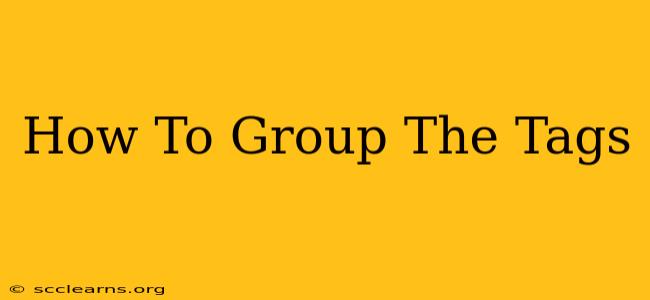Tagging is crucial for website organization and SEO. However, a haphazard approach to tagging can lead to a messy sitemap, diluted keyword power, and ultimately, poor search engine rankings. This guide will show you effective strategies for grouping your tags, maximizing their impact, and improving your website's overall SEO.
Understanding the Importance of Tag Grouping
Before diving into the how, let's clarify the why. Proper tag grouping offers several key benefits:
- Improved Site Structure: Well-organized tags create a logical hierarchy, making your website easier for both users and search engines to navigate. This leads to improved user experience and better crawl efficiency.
- Enhanced SEO: Grouping related tags strengthens their collective SEO power. Instead of spreading keyword authority thinly across numerous unrelated tags, you concentrate it on relevant themes, boosting your rankings for targeted keywords.
- Better User Experience: Users can easily find relevant content when tags are logically grouped. This improves site engagement and reduces bounce rates.
- Simplified Content Management: A well-structured tagging system simplifies content management, making it easier to update, categorize, and maintain your website's content.
Effective Strategies for Tag Grouping
Here are several effective methods for grouping your tags:
1. Hierarchical Tagging: The Parent-Child Approach
This method involves creating broad, overarching parent tags and then assigning more specific child tags under them. For example:
- Parent Tag:
Photography - Child Tags:
Landscape Photography,Portrait Photography,Wildlife Photography,Macro Photography
This creates a clear hierarchy, helping both users and search engines understand the relationships between different tags.
2. Thematic Tag Grouping: Clustering Related Concepts
Group tags based on common themes or topics. This approach is particularly useful when your website covers a wide range of subjects. For example, if your blog covers both travel and food, you might group your tags into these two main themes:
- Theme 1: Travel:
Travel Tips,Budget Travel,Backpacking,Adventure Travel,Luxury Travel - Theme 2: Food:
Recipes,Cooking Techniques,Restaurant Reviews,Food Photography,Healthy Eating
3. Keyword-Based Tag Grouping: Targeting Specific Search Terms
Identify your primary keywords and group tags around them. This strategy directly impacts SEO by focusing your tagging efforts on terms relevant to your target audience and search engine optimization goals. For example, if you sell handmade jewelry, you might group tags around:
- Keyword Group 1:
Handmade Jewelry,Artisan Jewelry,Custom Jewelry,Unique Jewelry - Keyword Group 2:
Necklaces,Earrings,Bracelets,Rings(These could further be subdivided by material - e.g.,Silver Necklaces,Gold Earrings)
4. Tag Clouds and Visual Representations
Visual representations of your tags can be incredibly helpful for understanding the relationships between them and identifying potential overlaps or gaps. Tag clouds visually represent the frequency of tags, allowing you to quickly identify the most popular and relevant ones.
Avoiding Common Tagging Mistakes
- Over-Tagging: Avoid stuffing too many tags into a single post. Focus on the most relevant and descriptive ones.
- Under-Tagging: Don't be afraid to use enough tags to accurately describe your content.
- Irrelevant Tags: Only use tags that are truly relevant to the content. Irrelevant tags dilute your SEO efforts.
- Duplicate Tags: Avoid creating multiple tags with similar meanings. Use a consistent terminology throughout your website.
Conclusion: Strategic Tagging for SEO Success
By implementing these strategies and avoiding common mistakes, you can create a well-organized and effective tagging system that improves both your website's SEO and user experience. Remember, tag grouping isn't a one-time task; it's an ongoing process that requires regular review and refinement to ensure its continued effectiveness. Regularly audit your tags, remove outdated ones, and add new ones as needed to keep your website's tagging system optimized.

